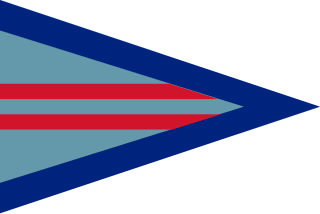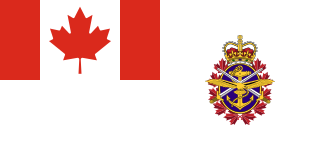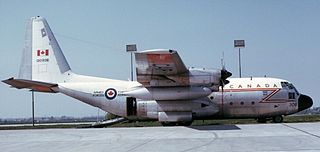
The unification of the Canadian Armed Forces took place on 1 February 1968, when the Royal Canadian Navy, Canadian Army, and Royal Canadian Air Force were merged to form the Canadian Armed Forces. [1]

The unification of the Canadian Armed Forces took place on 1 February 1968, when the Royal Canadian Navy, Canadian Army, and Royal Canadian Air Force were merged to form the Canadian Armed Forces. [1]
A white paper was tabled in the Parliament of Canada on 26 March 1964 by the Minister of National Defence, Paul Hellyer, and the Associate Minister of National Defence, Lucien Cardin. [2] This document outlined a major restructuring of the three separate armed services, describing a reorganization that would include the integration of operations, logistics support, personnel, and administration of the separate branches under a functional command system. The proposal met with strong opposition from personnel in all three services, and resulted in the dismissal of the navy's senior operational commander, Rear Admiral William Landymore, as well as the forced retirements of other senior officers in the nation's military forces. [3] The protests of service personnel and their superiors had no effect, however, and on 1 February 1968, Bill C-243, The Canadian Forces Reorganization Act, was granted royal assent, and the Royal Canadian Navy, the Canadian Army, and the Royal Canadian Air Force were combined into one service: the Canadian Armed Forces.
The public explanation for the reorganization was that unification would achieve cost savings and provide improved command, control, and integration of the military forces. Hellyer stated on 4 November 1966 that "the amalgamation... will provide the flexibility to enable Canada to meet in the most effective manner the military requirements of the future. It will also establish Canada as an unquestionable leader in the field of military organization." [4] However, the serving Liberal ministers of the Crown were accused of not caring for the traditions behind each individual service, especially as the long-standing navy, army, and air force identities were replaced with common army-style ranks and rifle green uniforms. Rather than loyalty to each service, which, as military historian Jack Granatstein put it, was "vital for sailors, soldiers, and airmen and women" who "risk their lives to serve," [5] Hellyer wanted loyalty to the new, all-encompassing Canadian Armed Forces (CAF); this, it was said, caused damage to the esprit de corps for sailors, soldiers, air crew and other personnel. [5]
As part of unification, the Royal Canadian Navy, the Canadian Army, and the Royal Canadian Air Force were merged and lost their status as separate legal entities. Most of the commands of the former services were eliminated and new unified commands were created. Army personnel and equipment were placed under an entity known as Mobile Command (later renamed Land Force Command). Navy personnel and ships were placed under Maritime Command. Personnel and aircraft of the former Royal Canadian Air Force were divided between Mobile Command, Maritime Command, Air Defence Command, Air Transport Command, and Training Command. In 1975 all aircraft of the Canadian Armed Forces were placed under a new command known as Air Command.
Most of the pre-unification corps that had been created in the early 20th century were disbanded or were merged with counterparts in the navy and air force to form the personnel branches of the CF.
The move toward unification, as well as other budget and cost-cutting moves during the 1980s and 1990s were opposed by many and is sometimes seen as a fault in the Canadian Forces. Many veterans objected to unification and sometimes referred to branches of the military by their pre-unification titles. In 2013 the traditional designation of "Royal" was restored to several of the branches listed above.
Over the ensuing decades, many of the elements of unification were incrementally reversed. The Communication Command was established on 1 September 1970, and Air Defence Command and Air Transport Command disbanded and their assets transferred to a new Air Command on 2 September 1975. This effectively restored a unified air force within the Armed Forces.
The Government of Brian Mulroney (1984–93) took steps which restored more traditional and distinct army, navy and air force uniforms to the Canadian Armed Forces, though the unified structure of the Armed Forces was maintained.
Materiel Command was disbanded during the 1980s, and Communications Command was disbanded during a mid-1990s reorganization, with its units merged into the Defence Information Services Organization (DISO), later renamed Information Management Group (IM Gp). Mobile Command was also renamed at this time, becoming Land Force Command (LFC). On 1 February 2006, the CF added four operational commands to the existing structure: Canada Command (CANCOM), Canadian Expeditionary Force Command (CEFCOM), Canadian Special Operations Forces Command (CANSOFCOM), and Canadian Operational Support Command (CANOSCOM). In 2012 CANCOM, CEFCOM and CANOSCOM were merged into Canadian Joint Operations Command.
On 16 August 2011 the three environmental commands of the Canadian Armed Forces were renamed to reflect the names of the original historical armed services. Air Command was changed to the Royal Canadian Air Force; Maritime Command was changed to the Royal Canadian Navy; and Land Force Command was changed to the Canadian Army. The government made the changes to align Canada with other key Commonwealth countries whose militaries use the royal designation, and to indicate that it respected Canada's military heritage. [6] [7]
The unified command structure of the Canadian Armed Forces was not altered by this change. Unlike the situation prior to 1968 where the services existed as separate legal entities, the current Royal Canadian Navy, Canadian Army, and Royal Canadian Air Force have no separate legal status and, under terms of amendments made to the National Defence Act in 2014, exist as commands within the unified Canadian Armed Forces. [8] [9]
Officers' insignia was also changed during this period of name restorations, to match the distinctive insignia worn by the three branches of the pre-unification era. The navy added the executive curl to their gold bars and reintroduced naval sleeve insignia for flag officers. The army abandoned the CF-style bars for pre-unification pips and crowns insignia, substituting the Canadian "Vimy Star" for the previous Star of the Order of the Bath, an insignia borrowed from the British order of chivalry. The air force changed their gold bar insignia to a composite braid in pearl grey, similar to patterns worn before unification. [10]
Corps is a term used for several different kinds of organization. A military innovation by Napoleon I, the formation was first named as such in 1805. The size of a corps varies greatly, but two to five divisions and anywhere from 40,000 to 80,000 are the numbers stated by the US Department of Defense.

The Canadian Armed Forces are the unified military forces of Canada, including land, sea, and air commands referred to as the Canadian Army, Royal Canadian Navy, and the Royal Canadian Air Force. The CAF also operates several other commands, including the Canadian Forces Intelligence Command, the Canadian Joint Operations Command, and the Canadian Special Operations Forces Command.
Second lieutenant is a junior commissioned officer military rank in many armed forces. The lowest officer rank, it is usually placed below lieutenant or first lieutenant.
The history of the Royal Canadian Air Force begins in 1914, with the formation of the Canadian Aviation Corps (CAC) that was attached to the Canadian Expeditionary Force during the First World War. It consisted of one aircraft that was never called into service. In 1918, a wing of two Canadian squadrons called the Canadian Air Force (CAF) was formed in England and attached to the Royal Air Force, but it also would never see wartime service. Postwar, an air militia also known as the Canadian Air Force was formed in Canada in 1920. In 1924 the CAF was renamed the Royal Canadian Air Force (RCAF) when it was granted the royal title by King George V. The RCAF existed as an independent service until 1968.
This is a table of the ranks and insignia of the Canadian Armed Forces. As the Canadian Armed Forces is officially bilingual, the French language ranks are presented following the English.
Canadian Forces Base Borden, formerly RCAF Station Borden, is a large Canadian Forces base located in Ontario. The historic birthplace of the Royal Canadian Air Force, CFB Borden is home to the largest training wing in the Canadian Armed Forces. The base is run by Canadian Forces Support Training Group (CFSTG) and reports to the Canadian Defence Academy (CDA) in Kingston.
Flying officer is a junior commissioned rank in the Royal Air Force (RAF) and the air forces of many countries which have historical British influence. It is also sometimes used as the English translation of an equivalent rank in countries which have a non-English air force-specific rank structure. In these cases a flying officer usually ranks above pilot officer and immediately below flight lieutenant.

Wing commander is a senior commissioned rank in the British Royal Air Force and air forces of many countries which have historical British influence, including many Commonwealth countries but not including Canada and South Africa. It is sometimes used as the English translation of an equivalent rank in countries which have a non-English air force-specific rank structure. It ranks immediately above squadron leader and immediately below group captain.
Chief Warrant officer is a senior warrant officer rank, used in many countries.

The Royal Canadian Air Force is the air and space force of Canada. Its role is to "provide the Canadian Forces with relevant, responsive and effective airpower". The RCAF is one of three environmental commands within the unified Canadian Armed Forces. As of 2020, the Royal Canadian Air Force consists of 12,074 Regular Force and 1,969 Primary Reserve personnel, supported by 1,518 civilians, and operates 258 manned aircraft and nine unmanned aerial vehicles. Lieutenant-General Eric Kenny is the current commander of the Royal Canadian Air Force and chief of the Air Force Staff.
The history of the Canadian Army, began when the title first came into official use in November 1940, during the Second World War, and is still used today. Although the official titles, Mobile Command, and later Land Force Command, were used from February 1968 to August 2011, "Canadian Army" continued to be unofficially used to refer to the ground forces of the Canadian Armed Forces, much as it has been from Confederation in 1867 to the present. The term was often even used in official military publications, for example in recruiting literature and the official newspaper of the Canadian Forces, The Maple Leaf. On August 16, 2011, the title, "Canadian Army", was officially restored, once again bringing the official designation in line with common and historical usage.

Canadian Forces Base Baden–Soellingen or CFB Baden–Soellingen, formerly known as RCAF Station Baden–Soellingen (Baden), was a Canadian Forces base located near the farming community of Söllingen, part of the municipality of Rheinmünster in the West German state of Baden-Württemberg. It is now a commercial area called Baden Airpark, which also includes the regional airport Flughafen Karlsruhe/Baden-Baden.
Before Unification as the Canadian Armed Forces in 1968, the Canadian military had three distinct services: the Royal Canadian Navy, the Royal Canadian Air Force, and the Canadian Army. All three services had a Regular (full-time) component and a reserve (part-time) component. The rank structure for these services were based on the services of the British military, the Royal Navy, the Royal Air Force, and the British Army. The change to a "Canadian" rank structure meant that many of the traditional (British) rank titles and insignia were removed or changed.
The uniforms of the Canadian Armed Forces are the official dress worn by members of Canada's military while on duty.

Personnel branches, in the Canadian Armed Forces (CAF), are groupings of related military occupations.

The Music Branch is a personnel branch of the Canadian Armed Forces (CAF). It is primarily composed of band musicians, and also deals with the selection and musical training of its recruits. The branch encompasses all the military bands in service in the Canadian Armed Forces. It is roughly the equivalent to the British Army's Royal Corps of Army Music (CAMUS).

A space command is a military organization with responsibility for space operations and warfare. A space command is typically a joint organization or organized within a larger military branch and is distinct from a fully independent space force. The world's first space command, the United States' Air Force Space Command was established in 1982 and later became the United States Space Force in 2019.

Canadian Forces Base Lahr was a military operated commercial airport located in Lahr, Germany. It was operated primarily as a French air force base, and later as a Canadian army base, beginning in the late 1960s. The military base was closed in 1994 and converted to civilian use. It is now known as the Flughafen Lahr.

Canadian military bands are a group of personnel in the Canadian Armed Forces (CAF) that performs musical duties for military functions. Military bands form a part of the Music Branch of the CAF, composed of six full-time professional Regular Force bands, 15 Regular Force voluntary bands, and 53 part-time reserve force bands. Bands of the Music Branch are often badged with the unit or Canadian Forces base insignia that they support.